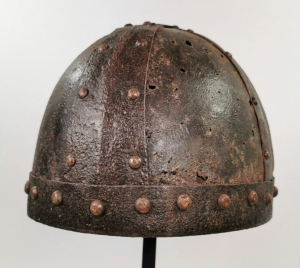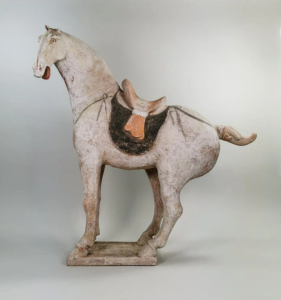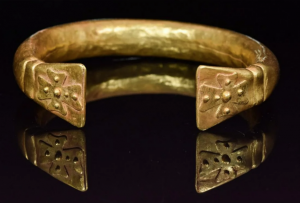London’s Pax Romana to host Feb. 1 no-reserve auction of fine ancient jewellery, classical & Asian antiquities, coins

Rare Viking iron helmet fabricated from four triangular iron plates with riveted construction, circa 900-1000 A.D. Provenance: Old British collection, acquired in UK in the 1980s. Estimate £5,000-£7,000 ($6,500-$9,100)
Ancient battle gear includes Viking weapons and rare riveted iron helmet; Greek Hoplite Chalcidian helmet of the type worn by Alexander the Great’s army
The auction catalogue is divided into five main categories of interest: Ancient Jewellery, Classical Antiquities, Ancient Weaponry, Asian Antiquities and Ancient Coins. Within the stellar lineup chosen for this sale are: a superb collection of ancient wearable jewellery in gold, silver and bronze; many exceptional ancient weapons, including swords, spears, axes and helmets; classical antiquities in marble, glass and terracotta; and a collection of Ancient Chinese and Gandhara figurines of peerless quality.
A large (23 x 10.92in) and quite remarkable Gandhara carved panel of grey schist stone is a detailed representation of Buddha life, with The Buddha seated on a center pedestal, flanked by adoring attendant figures. Dating to circa 200-300 A.D., this wonderfully detailed artwork is in fine condition and presented on a custom stand. Its current owner, a professional art expert in London, obtained the artwork from an old British collection that was formed in the 1970s. Estimate: £6,000-£8,000 ($7,800-$10,400)
Sculpted to a very high standard, a rare Gandhara grey schist head of Shayamuni Buddha exhibits sensitively detailed facial features, including an aquiline nose, half-closed eyes, incised pupils and a thin, hemmed mouth. The forehead is adorned with an urna, and the wavy hair is styled in a prominent usnisha on the top of the skull. A pleasing combination of classical carving traditions and Buddhist art, the 16.14 by 7.08in sculpture is expected to make £5,000-£7,000 ($6,500-$9,100).
A Chinese Northern Wei or early Tang Dynasty terracotta prancing horse, circa 400-600 A.D., shows impressive size at 24.8 by 24 inches. The design incorporates appealing painted details such as an open mouth, intelligently piercing eyes, a saddle and elaborate blanket with swirl accent. Fully authenticated by Ralf Kotalla Laboratory in Germany, this handsome fellow was previously held in an old British collection of Asian art. Auction estimate: £5,000-£7,000 ($6,500-$9,100).
A fine example of Chinese Tang dynasty art, a lifelike traditional ceramic depiction of a “fat court lady” holding a baby displays well preserved original pigments. Made circa 200 B.C. to 200 A.D., the 18.11- by 4.72-inch figure has been TL tested and confirmed authentic by Ralf Kotalla Laboratory. With provenance from a London private collection formed in 1970s, it carries a £2,500-£3,000 ($3,250-$3,900) estimate.
A highlight of the Ancient Roman section is an attractive marble relief figure of a dancing nymph or muse that measures 7.6 by 3.3 inches. Finely carved, the figure is distinguished by its thick, flowing “hair” and free-spirited pose. Once part of a British private collection formed in the 1980s, it will be offered with a £1,200-£1,600 ($3,600-$2,080) estimate.
Another Roman artwork of note is a rare, circa 200 A.D. sandstone head of Medusa with stylized serpents at its sides. “Although frightening, such carvings were often placed at the entrances of Roman villas or temples to repel bad spirits and evil creatures. The symbol was used more as a talisman for protection than actual horror figure,” Dr Bonchev explained. Measuring 10 by 9.4 inches on its included custom stand, the well provenanced carving is estimated at £2,500-£3,000 ($3,250-$3,900).
Endlessly fascinating, body armor and helmets worn by soldiers in ancient times are rarely found in museum-worthy condition, but that is the standard seen in two particular helmets entered in the February 1 auction. A highly prized circa 400 B.C. Greek Chalcidian Hoplite helmet with distinctive cheek-guards is of a type that was used by Alexander the Great’s army. With provenance from an old British collection, the professionally mounted relic could command a winning bid of £15,000-£25,000 ($19,500-$32,500).
The second featured helmet conjures images of 9th-century Danish king Ragnar Lothbrok and his eldest son, the cruel and ferocious Viking chieftain Ivar the Boneless. “They would fight and invade using the same type of riveted four-plate iron helmet as the one we are auctioning,” Dr Bonchev said. Made circa 900-1000 A.D., and with provenance from an old British collection, it is estimated at £5,000-£7,000 ($6,500-$9,100).
A full complement of sumptuous – and wearable – ancient jewellery includes rings, bracelets, necklaces, pendants and brooches, many of them set with precious gemstones. A large, solid-gold medieval (circa 1200 A.D.) Crusader’s bracelet weighing 40 grams is designed with flat terminals marked with Maltese crosses. “Solid-gold bangles of this type are particularly rare, and the Maltese crosses suggest ownership by a high-status knight or priest,” Dr Bonchev noted. The auction estimate is £6,000-£8,000 ($7,800-$10,400).
Around 200 A.D., a talented Roman engraver recounted the Greek mythological tale of Leda and the Swan through a carved amethyst intaglio set at the center of a gold Roman legionary ring. Previously part of a British private collection formed in the last quarter of the 20th century, it now comes to auction with a £3,000-£4,000 ($3,900-$5,200) estimate.
All auction items sold by Pax Romana are accompanied by a professional Certificate of Authenticity. The company ships worldwide, and all packing is handled by white-glove in-house specialists. View the fully illustrated catalogue and bid absentee or live online through LiveAuctioneers. For questions about any item in the February 1, 2020 auction, call Dr. Ivan Bonchev, Director, Pax Romana, London, on +44 7424 994167 or email director@paxromana.auction. Online: www.paxromana.auction
Dr. Ivan Bonchev
Pax Romana
email us here
+44 7424 994167
Legal Disclaimer:
EIN Presswire provides this news content "as is" without warranty of any kind. We do not accept any responsibility or liability for the accuracy, content, images, videos, licenses, completeness, legality, or reliability of the information contained in this article. If you have any complaints or copyright issues related to this article, kindly contact the author above.


